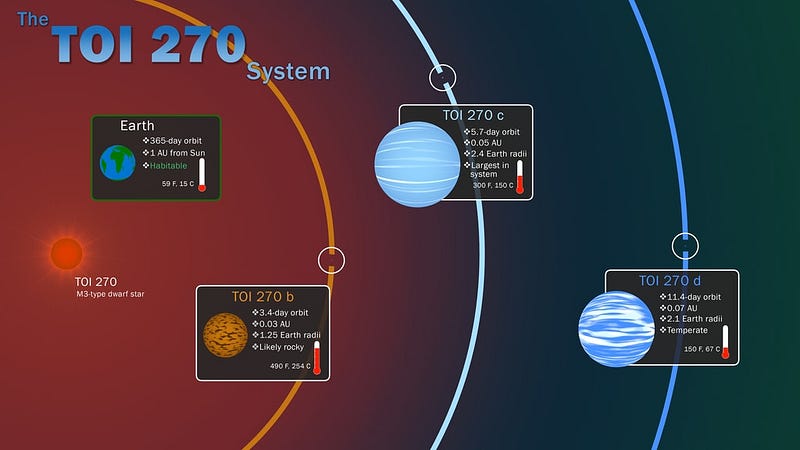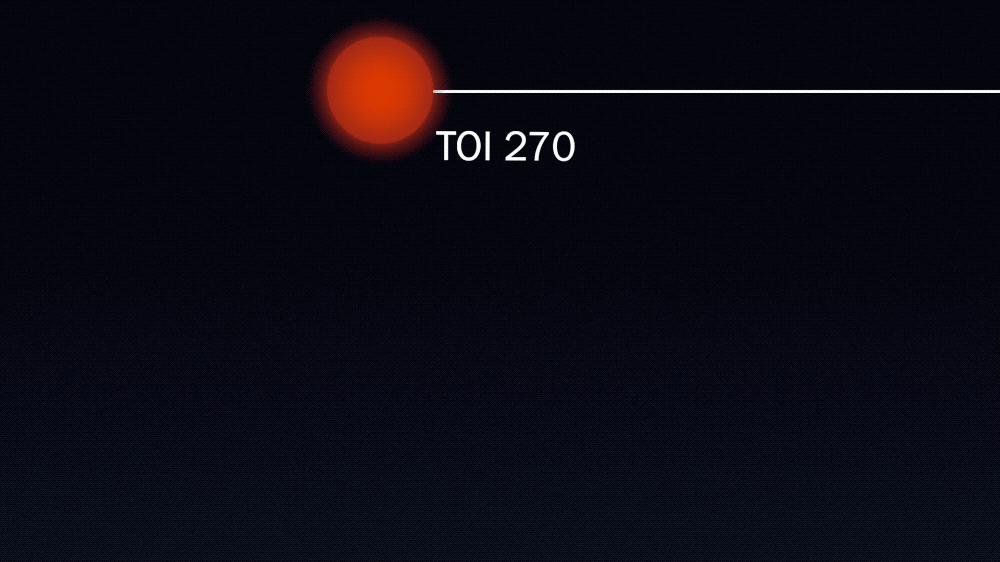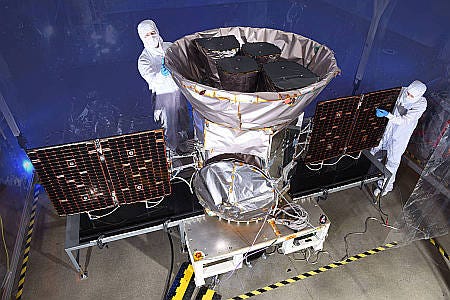Exploring TESS's Discovery of Three Unique Exoplanets
Written on
Chapter 1: TESS's Remarkable Find
NASA's Transiting Exoplanet Survey Satellite (TESS) has made significant strides in the search for exoplanets, uncovering three new worlds that orbit the star UCAC4 191–004642, located 73 light-years from Earth. This planetary system, now referred to as TOI (TESS Object of Interest) 270, hosts at least three planets. Among them is one that exceeds Earth's size, while the other two are categorized as sub-Neptunes, a type of planet not found in our own solar system. This star is relatively cool and faint, measuring about 40% smaller and less massive than the Sun, with a surface temperature approximately two-thirds that of our own star.

"This system is precisely what TESS was designed to discover — small, temperate planets that transit an inactive host star, one that shows minimal stellar activity," explained Maximilian Günther from the Massachusetts Institute of Technology. "This star is quiet and nearby, making it much brighter than those in similar systems."
Section 1.1: Understanding Our Cosmic Neighbors
The closest planet to the star, TOI 270 b, is about 25% larger and 90% more massive than Earth. Similar to our planet, TOI 270 b is rocky and completes its orbit in just 3.4 days, situated at a distance less than 8% of that between Mercury and the Sun, resulting in extreme temperatures. Without any atmospheric insulation, this planet would reach a scorching 254 degrees Celsius (490 Fahrenheit).
The next planet, TOI 270 c, is significantly larger at 2.4 times Earth's size and seven times its mass, orbiting its star every 5.7 days. If it had no atmosphere, its surface temperature would reach around 150 degrees Celsius (300 Fahrenheit), comparable to the heat of a conventional oven.

The third planet, TOI 270 d, orbits its star every 11.4 days and has five times the mass of Earth, contained within a sphere 2.1 times larger than our planet. If devoid of an atmosphere, its temperature would be around 67 degrees Celsius (150 Fahrenheit), possibly allowing extremophiles to survive, although the presence of an atmosphere could raise temperatures beyond life-sustaining levels.
All three of these planets are presumed to be tidally locked to their star, meaning one side perpetually faces the star, similar to how the Moon is in synchronous rotation with Earth.
Section 1.2: The TOI 270 Solar System
The TOI 270 system lies within the constellation Pictor and is so compact that the orbits of these three planets could fit within the family of moons that accompany Jupiter.

Our own solar system consists of four terrestrial planets (Mercury, Venus, Earth, and Mars), two gas giants (Jupiter and Saturn), and two ice giants (Uranus and Neptune). In contrast, sub-Neptunes, larger than Earth but smaller than Neptune, are the most commonly found planets in other solar systems.
Chapter 2: The Mystery of Habitability
The outermost planet, TOI 270 d, presents an intriguing case. Its temperatures are relatively moderate compared to the other planets, making it the most Earth-like in the system, yet it remains a rare example among sub-Neptunes. If it has a thick atmosphere, it might be too warm to support liquid water on its surface.
The absence of similar worlds in our solar system raises fascinating questions in astronomy. This discovery prompts inquiries about how these sub-Neptunes formed so close to smaller, rocky planets. "With extended follow-up observations, we’ll soon be able to determine the composition of these worlds, assess their atmospheres, and identify the gases present," Günther noted.
Ongoing research could uncover additional planets in the TOI 270 system, particularly those located further from the star, which may be cool enough to retain liquid water and potentially support life.
The unique combination of a rocky world and gaseous sub-Neptunes within this solar system is notable. The star at the center of TOI 270 is not only close but also relatively inactive, allowing astronomers to measure the brightness dips caused by orbiting planets effectively.
"We've identified very few planets like this within the habitable zone, especially around a quiet star, making this a rare find," said Stephen Kane, an associate professor of planetary astrophysics at the University of California Riverside.
The first video, "What Did NASA Discover With TESS' First Complete Mission," delves into TESS's findings and implications for exoplanet research.
The TESS mission was launched in April 2018, aboard a Falcon 9 rocket. In its inaugural year, TESS has identified over 20 exoplanets around distant stars, along with 900 unconfirmed candidates.

"One of the primary objectives of exoplanetary science is to detect small, temperate planets that transit in front of bright, quiet stars. This helps us characterize their sizes, orbits, compositions, atmospheres, and formation histories," researchers stated in a journal article published in Nature Astronomy regarding the TOI 270 discoveries.
TESS identifies new worlds by monitoring stars for dips in brightness caused by transiting planets, as observed from Earth.
Once the James Webb Space Telescope launches (anticipated in 2021), it will be equipped to analyze the atmospheres of these planets for signs of oxygen, carbon monoxide, and hydrogen, enhancing our understanding of the nature of the planets surrounding TOI 270 and other sub-Neptunes.
Currently, there are over 4,000 confirmed exoplanets known to orbit alien stars, and TESS is set to survey the entire sky, scrutinizing 200,000 of the brightest stars for previously unknown planets.
The second video, "TESS Discovers a Remarkable Earth-Like Planet In The Habitable Zone," highlights TESS's significant contributions to our understanding of potentially habitable worlds.